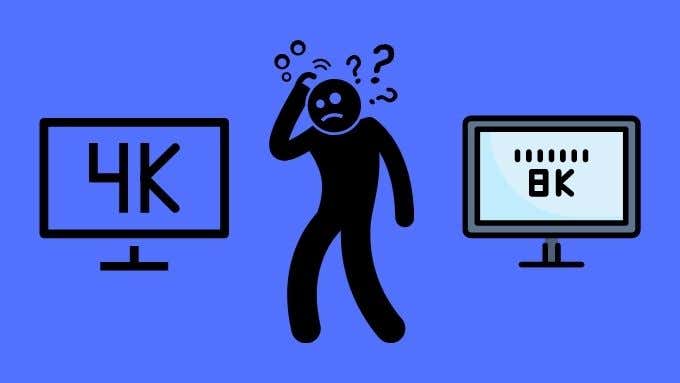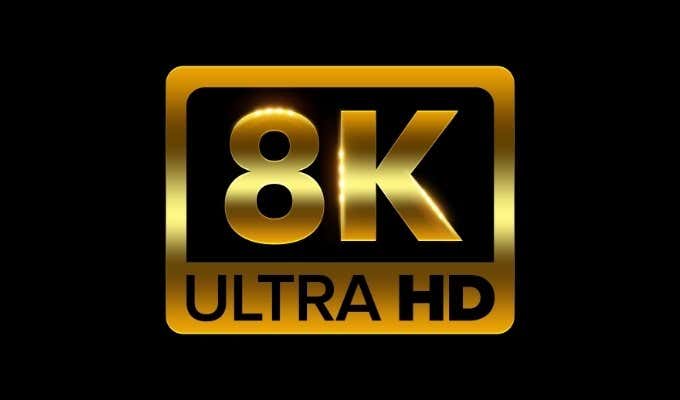There’s nothing worse than a technology buzzword when it comes to gaming consoles. You may be old enough to remember the console wars where terms like “blast processing” and how many “bits” a console had, dominated the conversation around these devices. Marketers love simple numbers where more is better. It means a potential buyer can look at two products and pick the one with higher numbers, even if they don’t really understand what those numbers mean. So, what is PS5 8K gaming? Is it worth it? Let’s bury the confusion once and for all.
What Does “8K” Mean?
The terms HD (High Definition), FHD (Full High Definition), 4K UHD (Ultra High Definition) and 8K are all just shorthand for different resolution standards. That is, how many rows and columns of pixels an image consists of or a particular display can show you. An FHD display has 1920 columns and 1080 rows of pixels arranged in a grid. That’s a total of 2073600 pixels! A 4K display doubles both those numbers to 3840×2160. Multiplying the columns by the rows yields 8294400 pixels. Exactly four times the number of FHD. 8K quadruples that figure again to 7680×4320 for 33177600 pixels! That’s a whopping four times the resolution of 4K and sixteen times the resolution of FHD. The higher the pixel count of a screen the more fine detail you can see. Assuming it has an image of the same quality to display. Although the amount of detail that’s in the picture isn’t the same as the amount of detail the human eye can see!
Why Is 8K Gaming so Hard?
Unlike a pre-recorded movie, a video game has to calculate the exact value of each pixel on screen in real time. Since video games are interactive media, the images can’t be prepared beforehand. You control camera movement and choices made in the game, so an extremely tight feedback loop exists from where you give the game commands using a controller and the image on screen changes in response. While the level of difficulty in rendering (that’s all the math needed to make the picture) doesn’t scale in a straight line as resolution goes up, it’s not far off. This implies that to render a game at 8K, you need (as much as) sixteen times the processing power compared to rendering it at FHD. If you can’t increase the amount of processing power the console (or computer) has, then you have to resort to other methods of reducing the workload on it:
Reduce the frame rate, providing more time to do the math for each image but with choppier motion.Decrease the quality of the render. (e.g. shadow detail, particle effects, etc.)
In both cases, you’re trading detail in another area to free up resources for a higher resolution. So you might have a sharper image, but the render is less pleasing to look at or runs with less fluidity.
Will There Really Be 8K Games on PS5 and Xbox Series X?
We have no doubt that there will be some titles that offer an 8K resolution mode at some point in the future. There are many simpler video games that would have no trouble running well at this resolution. We also expect that some backwards compatible games from the PlayStation 3 and Xbox 360 generation (and older) could get 8K resolution enhancements. Running brand-new triple-A quality games at 8K on existing console hardware can safely be considered out of reach. At least if games are rendered at “native” 8K resolution. These days video games can use dynamic resolution technology to render each frame at the resolution required to achieve a specific frame rate. So it’s conceivable that some games could dynamically target 8K, although rarely reach it.
Can I Play in 8K Today?
Even if you own one of the rare (and incredibly expensive) 8K displays on the market today, you still won’t be able to get 8K output from either the PS5 or Xbox Series X. There are no games on either platform that support this resolution. Despite “8K” being advertised on the packaging for new consoles,it’s a feature that still needs to be enabled. The only place you can currently play games in 8K is on a gaming PC. Even then, using the most powerful gaming hardware on Earth doesn’t offer great results, with serious compromises or upscaling technology needed to achieve playable frame rates.
120Hz and 4K are Worth Caring About
Borderlands 3 supports 120Hz gaming on console. With the latest generation of consoles, 8K resolution isn’t all that relevant. However, there are other aspects of these machines that are worth looking into for the average player. The CPUs in the PS5 and Xbox Series X are powerful enough to make high-frame rate gaming possible. If you have a TV that supports 120Hz visuals then you can enjoy a growing number of games that have 120fps modes. This offers hyper-smooth motion and razor-sharp responsiveness. In most cases this comes at the cost of resolutions below 4K or even below FHD, but it has a much more dramatic effect on gameplay than an 8K resolution would. The sweet spot for this generation thus far is gaming at 60 frames per second at a resolution targeting 4K.This is achievable for many cross-generation or previous-generation titles. At normal viewing distances 4K is noticeably sharper than FHD and doubling the frame rate from the last-generation’s 30 frames per second to 60 is a dramatic improvement. Virtually all modern flat panel displays support 60Hz output, so it’s also a much more accessible option.
8K Isn’t Worth It, for Now.
One of the biggest problems with 8K as a concept is that we’re reaching the limits of how much detail the human eye can perceive. At least when it comes to typical viewers, sitting at normal viewing distances relative to the size of the screen. Early in 2020, results of a study were published where participants took part in a double-blind experiment. Each participant was shown either an 8K or 4K image and had to rate which looked better. On average most people can’t tell the difference, although interestingly people with better than 20/20 vision could tell what was 8K or not with better accuracy. The overall conclusion is that the perceived improvement from 4K to 8K is one that most people can’t see and even those who can don’t rate it as particularly dramatic. That’s a different situation than the obvious increase in sharpness going from FHD to 4K. Then again, an FHD image is hardly blurry judged on its own merits. Even 4K becomes indistinguishable from FHD if you’re sitting too far from the screen relative to its size. So what’s the bottom line? Let’s lay it down:
Gaming at 8K requires massive amounts of processing power, which consoles and even top-end PCs don’t have, unless the game is older or relatively simple. 8K televisions and 8K content is currently nearly nonexistent.A 4K resolution with better refresh rates, contrast and color will create a much more dramatic perceived image quality improvement than 8K by itself.
We don’t recommend at this time that anyone should spare a thought for 8K. It will be a long time (if ever) for this next step in resolution to become relevant and it certainly isn’t going to be practical on current PS5 and Xbox Series X consoles.

![]()



